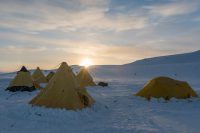With 17 different species of penguins, all of which have distinctive characteristics, answering the question “how long do penguins live?” is far from straightforward.
So how long do penguins live?
The lifespan of a penguin varies depending upon the species. Magellanic penguins can live up to 30 years – the longest lifespan of any penguin around the world – while little blue penguins have the shortest lifespan of up to six years.
However, there are other factors that can influence the length of time that a penguin lives. Penguins, like all animals, are known to live much longer in captivity as they are removed from their natural predators and have access to a reliable source of food. Penguin chicks are also more likely to survive into adulthood as a result of the protection from external threats that captivity provides.

Impact of climate change upon the expected lifespan of penguins
Unfortunately, the impact of humans on the planet, particularly through climate change, is responsible for changing the lifespans of penguins across the globe. Given the range of ocean habitats in which different species live, the actual impact of climate change on penguins varies significantly, but those found in the Antarctic Peninsula, such as the emperor penguin, are most at risk.
A rapid increase in temperatures is leading to a reduction in sea ice in Antarctica, causing diminished food availability and early mortality rates for chicks not yet prepared to swim in the ocean. As a result, the answer to “how long do penguins live?” is in the process of changing at an alarming rate.
Where do penguins live around the world?
Although popular belief suggests that penguins only inhabit the Antarctic, they’re actually found in a surprisingly wide range of habitats, not all of which are characterized by cold, icy conditions. In general, penguins tend to inhabit islands and remote continental regions that are free from land predators, as their inability to fly leaves them threatened on land.
Species such as Adélie and emperor penguins mostly inhabit the Antarctic Peninsula and around Antarctica, while rockhopper, macaroni, King and gentoo exist across the Antarctic and subantarctic islands, as well as a handful of locations in South America and a large number of penguin colonies on the Falkland Islands.

Species that inhabit places further north include Magellanic penguins, who range from Isla Magdalena in the Chilean fjords to Punta Tombo in Argentina, as well as the Galapagos penguin, which lives bordering the equator in the Galapagos Islands.
What diet do penguins have?
Again, the diet of penguins varies according to their species and their location around the world. Smaller penguin species inhabiting the Antarctic and subantarctic islands, such as Adélie, chinstrap and gentoo penguins, feed mainly on krill and squid.
Species further north, such as the Galápagos penguin, as well as Magellanic, Humboldt and African penguins, consume a larger quantity of fish.
1 comment
27 April, 2017 4:29 pm
Do they live alone or in a group






Leave a comment